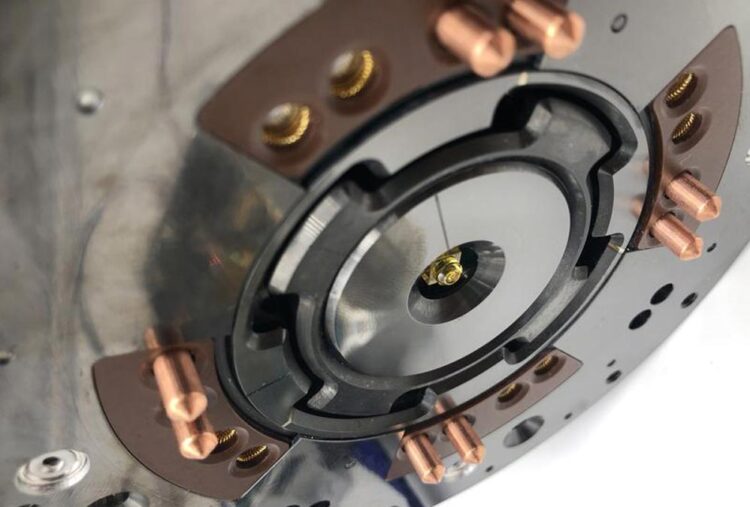Sustainable satellites using Li-Fi GigaDock® transceivers

iSSI® (intelligent Space System Interface) from iBoss GmbH, in which the LiFi Gigadock® transceiver from Fraunhofer IPMS is integrated.
(c) iBoss GmbH
Humans cause too much waste not only on Earth. Space debris is also becoming an ever greater problem. To make satellite systems more sustainable, they should be created in a modular system in the future so that individual components can be replaced, thus extending the service life of the satellites. To ensure a problem-free interface between the components, the Fraunhofer Institute for Photonic Microsystems IPMS has developed a transceiver that guarantees data transfer between the components. This was integrated into the iBOSS GmbH interface and has been on board the ISS (International Space Station) for testing purposes since February 2022.
There is international consensus in the space industry regarding the modularity of future satellite systems. In the future, such systems should be able to be flexibly disassembled and reassembled as in a modular system. The advantage of modular plug & play systems is that defective components can be replaced, thus significantly increasing the service life and function of a satellite. At the end of their lifetime, satellites either burn up in the earth’s atmosphere or remain in earth orbit. As a consequence, space debris is produced, which already generates enormous costs and effort and can become a real danger to life in manned space flight. The new generation of satellites will therefore replace the traditional architecture with a more sustainable and modular concept.
In order to be able to flexibly attach and detach modules directly in space, easy-to-couple and standardized components are particularly important. In addition to the mechanical coupling of the individual modules, it is essentially a matter of ensuring the transfer of data and energy between the individual modules so that satellites can be combined as required. For this reason, RWTH Aachen University applied for a patent years ago, which has now been brought to market by the spin-off iBOSS GmbH as iSSI® (intelligent Space System Interface) and forms a standard interface for such systems.
Part of the interface is a development of Fraunhofer IPMS and also known as Li-Fi GigaDock®. The core of the technology is an optical wireless transceiver, a highly integrated device that enables contactless full-duplex and bidirectional data transmission with a data rate of up to 5 Gbps. The possible transmission distance of the optical data interface is five centimeters. The component can also be used for rotor-to-stator transmission, as the transceiver functions perfectly even at high speeds.
“Building on this component, Fraunhofer IPMS has developed a communication module for iBOSS that has now made it into space, or to be more precise, even onto the ISS,” says a delighted Alexander Noack, head of development for optical wireless communication. “In addition to space travel, the component can be found in industrial communication systems, in medical technology as well as in docking applications,” he continues.
In February, the interface flew into space for testing and demonstration purposes and was mounted by a robot for the first time on the Japanese part of the ISS. The module is to remain there until mid-December and prove its operational capability under vacuum conditions and the influence of radiation.
Interested parties can find out more about the technology at the Electronica trade fair in Munich from November 15 – 18, 2022. Fraunhofer IPMS will exhibit its LiFi developments in hall B4 (booth B4.258).
Media Contact
All latest news from the category: Physics and Astronomy
This area deals with the fundamental laws and building blocks of nature and how they interact, the properties and the behavior of matter, and research into space and time and their structures.
innovations-report provides in-depth reports and articles on subjects such as astrophysics, laser technologies, nuclear, quantum, particle and solid-state physics, nanotechnologies, planetary research and findings (Mars, Venus) and developments related to the Hubble Telescope.
Newest articles

NASA: Mystery of life’s handedness deepens
The mystery of why life uses molecules with specific orientations has deepened with a NASA-funded discovery that RNA — a key molecule thought to have potentially held the instructions for…

What are the effects of historic lithium mining on water quality?
Study reveals low levels of common contaminants but high levels of other elements in waters associated with an abandoned lithium mine. Lithium ore and mining waste from a historic lithium…

Quantum-inspired design boosts efficiency of heat-to-electricity conversion
Rice engineers take unconventional route to improving thermophotovoltaic systems. Researchers at Rice University have found a new way to improve a key element of thermophotovoltaic (TPV) systems, which convert heat…



